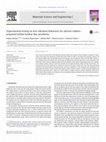Papers by Carmen Bujoreanu
Applied Mechanics and Materials, 2016
Applied Mechanics and Materials, 2016
Applied Mechanics and Materials, 2015
The paper presents theoretical and experimental results on friction moment and temperature evolut... more The paper presents theoretical and experimental results on friction moment and temperature evolution in axially preloaded high-speed hybrid ball bearings lubricated by mineral oil and kerosene mist. At high-speed, the performances of kerosene mist lubricated bearings are limited by the developed temperature, the viscosity of the kerosene being about ten times lower than of industrial oils. As observed during the tests, the kerosene-mist lubrication give good results for light load and a speed parameter (mean diameter of the ball bearing multiplied by the shaft speed) up to 1 million mm x rpm. For the tested 7206C ball bearings, the corresponding shaft speed is about 20 000 rpm. The obtained theoretical and experimental results are in good agreement, the measured and the predicted values of the friction moment having the same trend.
The EHD mechanism is the “miracle mechanism” for life and durability. The key to unlock the myste... more The EHD mechanism is the “miracle mechanism” for life and durability. The key to unlock the mysteries behind oil physical properties and chemical attributes is the identification of the functional regions of a lubricated contact. Some experiments related to a severe wear leading to contact catastrophic damage are presented and emphasize the mean parameters controlling lubrication and failure mechanisms. The test method invokes tribological interactions measured in terms of friction, gentle polishing wear of surface features, adhesive wear events and scuffing. With respect to lubrication and failure mechanisms for a given tribo-contact system, we propose that the key performance parameters are the entraining velocity, the sliding velocity, and temperature.

Applied Mechanics and Materials, 2015
Vibration based fault detection and diagnose analysis is a well established field in machine or m... more Vibration based fault detection and diagnose analysis is a well established field in machine or monitoring supervision. The vibration diagnose is also suited for the miniature ball bearings monitoring. The typical balls size starts at 3 mm with the bearing outer diameter of maximum 20 mm. Ball bearings of this size are ideal for precision mechanisms, they are able to carry light loads and they are perfect for handheld medical equipment and tools which must be very small but also very precise and durable. The paper presents experiments carried out on a fully instrumented universal CETR micro-tribometer at room temperature. The tested miniature ball bearing, lightly loaded and operating at low speeds, is subjected to dry and lubrication conditions with two different oil viscosities. A comparative study is realized concerning the vibration diagnose potential using the FFT analysis of the bearing acquired signals. Statistical analysis of the vibration signals is a key point in the detection of the overall vibration level of bearings lubricated with oils of different viscosities.

Lubrication Science, 2000
ABSTRACT The piston ring is one of the main elements in an internal combustion engine. Together w... more ABSTRACT The piston ring is one of the main elements in an internal combustion engine. Together with the cylinder sleeve, the piston ring has two basic functions: (1) contacting the cylinder sleeve to prevent the gases formed above the piston from migrating to the crankcase and (2) as a translation couple, formed of the piston-ring and cylinder-sleeve assembly.Complex tribological phenomena occur in the piston-ring and cylinder-sleeve tribosystem, according to variations in sliding speed, gas pressure, and temperature.This paper presents a method of calculation of the thickness of the lubricant film in the piston-ring and cylinder-sleeve tribosystem, using the Reynolds equation, integrated in specific conditions. According to the Newtonian behaviour of the lubricant, the shear stresses in the lubricant film between the piston ring and cylinder sleeve are determined. A computational procedure to determine flash temperatures in the piston-ring and cylinder-sleeve tribosystem is presented. The theoretical results, including film thickness, sliding speed, gas pressure, and flash temperatures for a complete crankshaft cycle are also presented.

Many studies regarding the ball motion for bearings running in a normal range of operating condit... more Many studies regarding the ball motion for bearings running in a normal range of operating conditions have been reported, but in incorrect running the references are insufficiently. The brake effect on the ball bearing's cage can lead to abnormal operation characterised by gross sliding speed between ball and inner race and occasionally to premature bearing failure, that is usually micro-scuffing or scuffing. For these conditions the known kinematics hypothesis cannot be used. Based on the power loss equilibrium regarding the ball-races and ball-cage interactions, a simplified analytical kinematics model has been developed by authors. Under sliding conditions, the Kinematics model developed is correlated to the scuffing model that relies on the dissipation function of energy dissipated within the EHD oil film. Both models leads to perform a computational algorithm to estimate the scuffing risk for an angular contact ball bearing, useful for the bearings designers and users.

Materials Science and Engineering: C, 2014
This research was focused on the damping capacity study of two types of silicone rubbers proposed... more This research was focused on the damping capacity study of two types of silicone rubbers proposed as layers within total lumbar disc prostheses of ball-and-socket model. In order to investigate the damping capacity, the two silicone rubber types mainly differing by the molecular mass of polymeric matrix and the filler content, as was emphasized by scanning electron microscopy and differential scanning calorimetry, were subjected to free vibration testing. Using an adapted experimental installation, three kinds of damping testing were realised: tests without samples and tests with three samples of each type of silicone rubber (69 ShA and 99 ShA). The free vibration tests were performed at a frequency of about 6 Hz using a weight of 11.8 kg. The relative damping coefficient was determined by measuring of two successive amplitudes on the vibrogram and calculating of the logarithmic decrement. The test results with silicone rubber samples showed a relative damping coefficient of 0.058 and respectively 0.077, whilst test results without samples showed a relative damping coefficient of 0.042. These silicone rubbers were found to have acceptable damping properties to be used as layers placed inside the prosthetic components.

2013 E-Health and Bioengineering Conference (EHB), 2013
The purpose of this work was to investigate the fatigue resistance of a silicone rubber proposed ... more The purpose of this work was to investigate the fatigue resistance of a silicone rubber proposed as layers placed inside the prosthetic components within the total lumbar disc prosthesis in order to improve its damping capacity. The silicone rubber samples used in this study were prepared by incorporation of high amount of silica (70% wt) in a polydimethylsiloxane-α,ω-diol of high molecular mass followed by processing in stable form of cylinders by pressing in a proper mould and vulcanization. In order to evaluate the fatigue resistance, three silicone rubber samples were subjected to forced vibration for a period of 4h at a vibration frequency of about 9 Hz. Before and after the fatigue resistance testing, the samples were tested from the free vibration response point of view. The experimental results showed that the free vibration response of the silicone rubber samples before and after the fatigue resistance testing was the same.
omg.ugal.ro
This paper reviews the rolling linear guidance systems (LGS), the Romanian researchers' approache... more This paper reviews the rolling linear guidance systems (LGS), the Romanian researchers' approaches in this field being few and related to guidance systems of minor complexity. The great LGS producers give some information concerning the dimensions, shape, mounting conditions and exploitation in their catalogues. On the other side, their design and computation algorithm are not revealed.
The authors determined the local scuffing criterion for rolling/sliding contacts by considering b... more The authors determined the local scuffing criterion for rolling/sliding contacts by considering both the roughness on surfaces and lubricant film. The real pressure distributed in rolling/sliding contact operating in mixed lubrication conditions has been determined. Also the tangential shear stress correlated with the lubricant parameter λ was obtained and finally the local scuffing criterion SL was calculated for given rollers geometry and operating conditions.
Applied Mechanics and Materials, 2014
An experimental study has been performed both on the specimens and original test rig to estimate ... more An experimental study has been performed both on the specimens and original test rig to estimate scuffing limits in angular contact ball bearings. From the scuffing approaches, it can be detached the idea that, any scuffing mechanism considered, there is an energetically unbalance in the rolling contact. Therefore we consider an energetically criterion the most adequate to estimate scuffing limits. Corroboration between our experimental and theoretical results allows a scuffing criterion to estimate this type of damage in 7206 angular contact ball bearing. The proposed scuffing criterion can be considered of practical use for ball bearings designers and producers in order to predict scuffing risk.

2013 E-Health and Bioengineering Conference (EHB), 2013
The purpose of this work was to investigate the fatigue resistance of a silicone rubber proposed ... more The purpose of this work was to investigate the fatigue resistance of a silicone rubber proposed as layers placed inside the prosthetic components within the total lumbar disc prosthesis in order to improve its damping capacity. The silicone rubber samples used in this study were prepared by incorporation of high amount of silica (70% wt) in a polydimethylsiloxane-α,ω-diol of high molecular mass followed by processing in stable form of cylinders by pressing in a proper mould and vulcanization. In order to evaluate the fatigue resistance, three silicone rubber samples were subjected to forced vibration for a period of 4h at a vibration frequency of about 9 Hz. Before and after the fatigue resistance testing, the samples were tested from the free vibration response point of view. The experimental results showed that the free vibration response of the silicone rubber samples before and after the fatigue resistance testing was the same.
Applied Mechanics and Materials, 2014
Applied Mechanics and Materials, 2014
ABSTRACT
Applied Mechanics and Materials, 2014
Applied Mechanics and Materials, 2014








Uploads
Papers by Carmen Bujoreanu